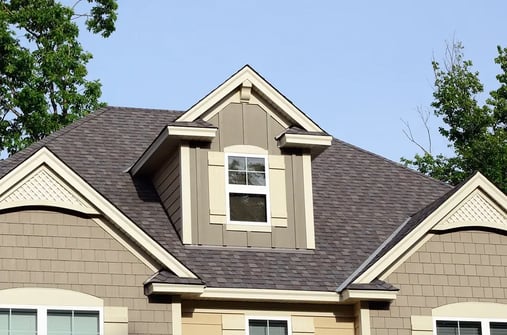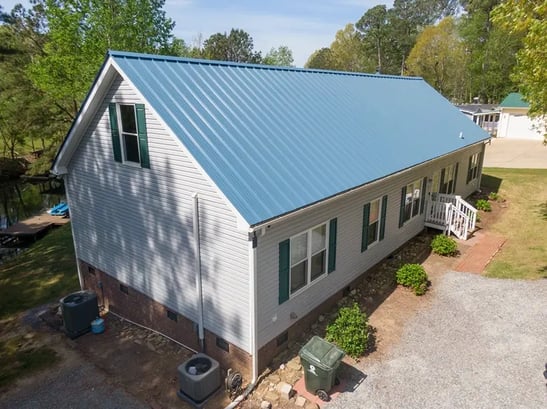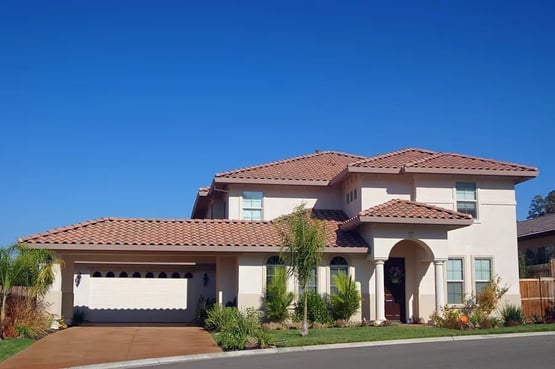Everything’s bigger in Texas - including the hail.
Here in the Lone Star State, your roof can take a beating - from the hail, the heat, and the humidity. In fact, if a roof has a typical lifespan of 30 years in a milder part of the country, it may only last half that time here.
So the question is: how long do different types of roofs last in Texas, and what can you do to ensure your longevity?
That’s the question we’ll answer in this article. Read on to learn how long a residential roof typically lasts in Texas, what factors influence its lifespan, and what you can do to extend it.
How Long Do Asphalt Shingle Roofs Last In Texas?

Typical Lifespan: 10-30 years
Asphalt shingles are the most popular roofing material in the United States and for good reason. They are affordable, easy to install, and come in an endless variety of styles and colors. However, in Texas, asphalt shingles have a few challenges.
Cons in Texas Climate:
- Heat Sensitivity: Texas summers can be brutal, with temperatures often soaring above 100°F. Prolonged exposure to such intense heat can cause asphalt shingles to deteriorate more quickly, leading to curling, cracking, and loss of granules.
- Storm Vulnerability: Texas is no stranger to severe storms, including hail and high winds. Asphalt shingles can be susceptible to damage from these conditions, which may shorten their lifespan.
Pros:
- Affordability: Asphalt shingles are one of the most cost-effective roofing materials available, making them a popular choice for many homeowners.
- Variety: They offer a wide range of aesthetic options, allowing you to customize the look of your home.
How Long Do Metal Roofs Last In Texas?

Typical Lifespan: 40-75 years
Metal roofing is becoming increasingly popular in Texas due to its durability and energy efficiency. Whether made of steel, aluminum, or copper, metal roofs offer several advantages.
Pros:
- Durability: Metal roofs are highly resistant to extreme weather conditions, including high winds, hail, and even fire. This makes them an excellent choice for Texas, where we get more hailstorms than any other part of the country.
- Energy Efficiency: Metal roofs reflect a significant amount of the sun’s heat, which helps keep your home cooler during Texas’ scorching summers.
Cons in Texas Climate:
- Initial Cost: Metal roofing is more expensive upfront compared to asphalt shingles. However, the investment often pays off over time due to its long lifespan and energy savings.
- Noise: Without proper insulation, metal roofs can be noisier during heavy rain or hailstorms, which are common in Texas.
How Long Do Tile Roofs Last In Texas?

Typical Lifespan: 50-100 years
Tile roofing, made from either clay or concrete, is known for its longevity and classic aesthetic appeal. It’s popular throughout the southwestern United States, including Texas, because it performs so well in the heat.
Pros:
- Heat Resistance: Tile roofs are excellent at withstanding high temperatures, which is a huge benefit in Texas. The tiles reflect sunlight and provide natural ventilation, which helps keep your home cool.
- Durability: Tile roofs are incredibly durable and can withstand hail and high winds, making them suitable for Texas’s unpredictable weather.
Cons in Texas Climate:
- Weight: Tile roofing is heavy, which means your home’s structure must be able to support it. This can increase the cost of installation if additional structural support is needed.
- Cost: Tile roofing is more expensive than other options like asphalt shingles and metal. However, its long lifespan may make it a good investment in the long run.
How Long Does Wood Shake Roofs Last In Texas?
Typical Lifespan: 20-40 years
Wood shingles and shakes offer a natural, rustic look that appeals to many homeowners. However, they come with specific considerations that must be taken into account given the Texas climate.
Pros:
- Aesthetic Appeal: Wood shingles and shakes provide a unique, natural appearance that can enhance the beauty of your home.
- Insulation Properties: Wood is a natural insulator, which can help regulate your home’s temperature, keeping it warmer in the winter and cooler in the summer.
Cons in Texas Climate:
- Vulnerability to Rot: Texas’s humidity and frequent rain can pose a significant challenge to wood roofing. Without proper maintenance, wood shingles and shakes can absorb moisture, leading to rot and mold growth.
- Fire Risk: In areas prone to wildfires or intense heat, wood roofing can be a fire hazard. While treatments are available to make wood more fire-resistant, this adds to the cost and maintenance requirements.
How Long Do Slate Roofs Last In Texas?
Typical Lifespan: 75-100+ years
Slate roofing is known for its exceptional durability and timeless appearance. It’s one of the longest-lasting roofing materials available, making it a premium choice for homeowners seeking longevity.
Pros:
- Extreme Durability: Slate is incredibly durable and resistant to fire, water, and severe weather conditions, including Texas’s intense heat and storms.
- Aesthetic Excellence: Slate roofs offer a unique, elegant appearance that can significantly enhance your home’s curb appeal.
Cons in Texas Climate:
- High Cost: Slate is one of the most expensive roofing materials on the market, both in terms of material and installation costs. However, its longevity often justifies the investment.
- Weight Concerns: Like tile roofing, slate is very heavy, which may require additional structural support. This adds to the complexity and cost of installation.
4 Signs Your Roof May Need Replacement
OK, so roofs don't last as long in Texas, but how do you know if you really need to replace yours? Here are the key things to look for:
1. Visible Damage
One of the most obvious signs that your roof may need replacing is visible damage. Having regular inspections from a professional, especially after severe weather, can help you spot these issues early (which can prevent a simple repair job from turning into a full replacement).
- Cracked, Curled, or Missing Shingles: Asphalt shingles are prone to wear and tear over time, especially in Texas’s harsh climate. If you notice shingles that are cracked, curled at the edges, or entirely missing, it’s a clear sign that your roof is aging and may need replacement soon.
- Rust or Corrosion on Metal Roofs: Metal roofs are durable, but they’re not immune to the effects of Texas’s weather. If you notice rust spots, corrosion, or other signs of wear on your metal roof, it’s an indicator that the protective coating has worn away. This can lead to leaks and structural damage if not addressed right away.
2. Leaks and Water Damage
Water is one of the most damaging forces for any roof. If water is getting through your roof, it’s a serious issue that needs immediate attention.
- Water Stains on Ceilings or Walls: If you notice dark or discolored spots on your ceilings or walls, it’s a sign that water is seeping through your roof. This can happen when shingles are damaged, or the flashing around vents, chimneys, or skylights has deteriorated. Ignoring these stains can lead to more extensive damage to your home, including structural damage and unhealthy mold growth.
- Mold or Mildew Growth: Mold and mildew thrive in damp environments. If you spot mold or mildew in your attic, on your walls, or around your roofline, it’s a strong indication that your roof isn’t keeping out moisture effectively. In Texas, where humidity levels can be high, mold can spread quickly, leading to health problems and costly repairs.
3. Age of the Roof
As we’ve discussed, different roofing materials have varying lifespans, and knowing where your roof stands can help you plan ahead.
- Knowing the Age of Your Roof: Most roofing materials have a general lifespan. For instance, asphalt shingles typically last 10-30 years, while metal roofs can last 40-70 years. If your roof is approaching or has exceeded its expected lifespan, it’s time to start considering a replacement.
- Understanding When It’s Nearing the End of Its Lifespan: Besides the general age, pay attention to how your roof is holding up. Older roofs often require more frequent repairs, and if you’re finding yourself patching up problems regularly, it might be more cost-effective to replace the entire roof. Additionally, as roofs age, they can lose their ability to insulate your home properly, leading to other issues like increased energy bills.
4. Energy Efficiency Issues
Your roof plays a critical role in your home’s energy efficiency. An aging roof can lead to higher energy costs, which is a sign that it might be time for a replacement.
- Rising Energy Bills Due to Poor Insulation: If you’ve noticed a spike in your energy bills, especially during the hot Texas summer, your roof could be to blame. An older roof may lose its ability to reflect heat effectively, causing your air conditioning to work harder to keep your home cool. This is particularly true for materials like asphalt shingles, which can degrade under intense heat. If your roof’s insulation properties are compromised, replacing it with a more energy-efficient material could save you money in the long run.
Roof Repair vs. Replacement
If you do have roof damage, how do you know if you need a full replacement or a simple repair?
Both options have their pros and cons, and the right choice depends on several factors, including the extent of the damage, the age of your roof, and your long-term plans for your home. Let’s break it down:
The Extent of the Damage
The first step is to determine how severe the damage is.
- Minor Damage: If the damage is limited to a small area—like a few missing shingles or a minor leak—repairing your roof is often the most cost-effective solution. A localized repair can extend the life of your roof without the need for a full replacement, especially if the rest of the roof is in good condition.
- Widespread or Severe Damage: However, if the damage is extensive—such as widespread shingle loss, significant leaks, or structural issues—repairing may not be enough. In these cases, replacing the roof is likely the better option to ensure your home is fully protected. Widespread damage often indicates that the roof is nearing the end of its lifespan, making replacement a more durable and long-lasting solution.
Age of Your Roof
The age of your roof is another critical factor in the repair vs. replacement decision.
- Newer Roofs (Less than 10-15 Years Old): If your roof is relatively new and still within the expected lifespan of its materials, repairing any damage makes sense. Newer roofs can typically withstand repairs and continue to perform well for many more years. Plus, many newer roofs come with warranties that may cover certain types of repairs, reducing your out-of-pocket costs.
- Older Roofs (Approaching or Exceeding 20 Years): On the other hand, if your roof is nearing the end of its lifespan, even minor repairs may only serve as a temporary fix. An older roof is more likely to experience recurring issues, leading to repeated repair costs that add up over time. In such cases, replacing the roof is often more cost-effective in the long run, providing you with a new, durable roof that won’t require constant attention.
Weighing the Costs
Cost is always a significant factor when deciding between repairing or replacing your roof.
- Repair Costs: Roof repairs are generally less expensive upfront than a full replacement. If the damage is minimal, repair costs can be quite manageable. However, if repairs become frequent, the cumulative cost can rival that of a new roof, without offering the same long-term benefits.
- Replacement Costs: Replacing your roof is a bigger investment, but it can be more cost-effective over time, especially if your roof is old or has suffered significant damage. A new roof eliminates the need for ongoing repairs, and with advancements in roofing materials, you may also benefit from improved energy efficiency and increased home value. Additionally, a new roof provides peace of mind, knowing your home is protected for many years to come.
Long-Term Plans for Your Home
Your long-term plans for your home should also influence your decision.
- Staying Long-Term: If you plan to stay in your home for many years, investing in a roof replacement makes sense. A new roof will ensure your home remains protected and comfortable, and it can save you from the inconvenience and cost of repeated repairs.
- Selling Soon: If you’re planning to sell your home in the near future, consider how your decision will impact the sale. A new roof can significantly increase your home’s curb appeal and market value, making it more attractive to potential buyers. On the other hand, if the damage is minor and your roof has some life left in it, a repair might suffice, especially if you’re looking to avoid the upfront cost of a replacement.
Professional Inspection and Advice
Ultimately, the best way to decide between roof repair and replacement is to consult with a professional roofing contractor.
- Roof Inspection: A thorough inspection by a roofing professional can provide you with a detailed understanding of your roof’s condition. They can assess the extent of the damage, the remaining lifespan of your roof, and the potential costs of both repair and replacement.
- Expert Recommendations: Based on their findings, a professional can recommend the best course of action, tailored to your specific situation and budget. They can help you weigh the short-term and long-term implications of each option, ensuring you make a decision that aligns with your needs and goals.
The good news: most roofing companies will offer you a professional inspection at no charge.
The Upshot
In Texas, where the weather is as intense as it is unpredictable, your roof plays a vital role in protecting your home.
Whether you’re considering a roof repair or a full replacement, understanding the condition of your roof and the unique challenges it faces in Texas is key to making the best decision for your home. By staying proactive with inspections and maintenance, you can extend the life of your roof, protect your investment, and ensure your home remains safe and comfortable for years to come. If you’re unsure about the state of your roof, a professional inspection is a great next step to get the expert advice you need.

